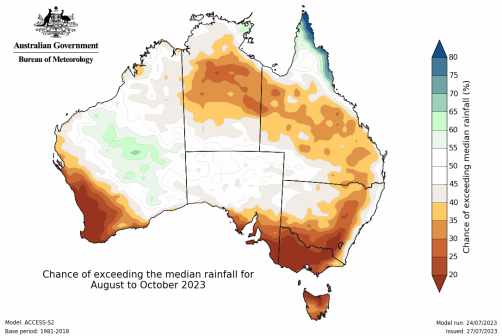The overall forecast for Australia from August to October indicates below median rainfall and above median temperatures for large parts of the nation. Influenced by factors such as likely El Niño development and potential positive Indian Ocean Dipole (IOD), these conditions may create a challenging fire season, particularly in southern and eastern regions.
So what are these key factors, and how do they impact Australia’s weather?
El Niño: A well-known climate phenomenon, El Niño typically increases the chance of below-average winter–spring rainfall for the eastern half of Australia, as well as above-average daytime temperatures for the southern two-thirds. These conditions can lead to drier landscapes, raising fire risks.
Indian Ocean Dipole (IOD): The IOD refers to differences in sea surface temperatures between the western and eastern parts of the Indian Ocean. A positive IOD phase is likely to develop during late winter or early spring and typically decreases winter–spring rainfall for much of Australia. This reduction in rainfall can exacerbate dry conditions, further heightening the risk of wildfires. The current outlook suggests that the likely development of a positive IOD aligns with the forecasted below median rainfall in various regions, amplifying the overall fire risk.
Longer-term Climate Trends: Australia's climate has warmed by around 1.47 °C since 1910, leading to more frequent and severe extreme heat events. Southern Australia has also seen a 10 to 20% reduction in cool season (April to October) rainfall in recent decades. The combination of increased temperatures and reduced rainfall contributes to drier conditions, creating environments that are more susceptible to fire ignition and spread.
These factors collectively paint a complex picture of the potential fire risks across the nation. Understanding these climate drivers helps in forecasting fire behaviour and implementing preventive measures tailored to the specific conditions of each region. The following analysis explores the regional outlooks, reflecting on both the latest forecast data and historical trends, to provide insights and recommendations for a safe and prepared fire season.
Region Specific Forecast and Outlook
New South Wales (NSW)
- Fire Outlook: Below median rainfall is expected for most of NSW, except coastal areas. Historically, NSW has faced significant wildfire challenges in drier inland areas. The current forecast may exacerbate fire risks, particularly in regions that align with historical trends of dry conditions leading to wildfires. Coastal areas, typically receiving higher rainfall, may see fewer risks, but ongoing vigilance is required.
Victoria (VIC)
- Fire Outlook: Below median rainfall is very likely for large parts of Victoria, making certain areas at least twice as likely to receive unusually low rainfall. Victoria's varied climate has led to different fire regimes, and the current forecast aligns with historic trends of increased fire risks, particularly in the north and northwest, elevating wildfire susceptibility in forested and grassland regions.
Queensland (QLD)
- Fire Outlook: Below median rainfall is very likely for western parts of Queensland, while above median rainfall is expected near Cape York Peninsula and the Mackay Coast. Queensland's tropical and subtropical climate leads to mixed fire conditions. The western regions, historically facing higher fire risks during dry periods, may see continued trends, while wetter regions may experience reduced risks.
Western Australia (WA)
- Fire Outlook: Below median rainfall is very likely for WA's South West Land Division. WA's vast landscape and climate variability contribute to diverse fire behaviours. The current forecast may increase risks in this division, particularly in bushland and forested areas, reflecting recurring fire events in past dry periods.
South Australia (SA)
- Fire Outlook: Areas of south-east SA are at least twice as likely to receive unusually low rainfall. South Australia's arid climate and history of bushfires align with this prediction, potentially leading to heightened fire risks in vulnerable regions, reflecting historical trends in areas like the Mount Lofty Ranges and Adelaide Hills.
Tasmania (TAS)
- Fire Outlook: Most of Tasmania is at least twice as likely to receive unusually low rainfall. Tasmania's varied topography and climate may increase fire risks, aligning with past trends where dry conditions have led to significant fire events, especially in the eastern and central parts.
Australian Capital Territory (ACT) and Northern Territory (NT)
- Fire Outlook: The forecast for ACT and NT varies across regions. ACT's relatively small geographical area and NT's tropical climate often lead to different fire regimes. The specific forecast details, combined with historical patterns, show that dry conditions can increase fire risks in both territories. However, understanding local weather patterns and historical trends is essential for targeted preparedness.
In summary, the upcoming fire season presents a multifaceted picture of potential risks across Australia. The influence of climate drivers such as El Niño and the positive IOD, coupled with the forecasted weather conditions, emphasises the need for vigilance and region-specific preparedness.
At TracPlus, our expertise in wildfire response and aviation guides our ongoing commitment to public safety and awareness. We believe that knowledge and collaboration are key to effective wildfire management, and we are proud to contribute to the broader understanding of fire risks and mitigation strategies.
In this context, TracPlus remains committed to not only supporting wildfire response efforts but also enhancing their efficiency through our leading software solutions. By providing real-time tracking, communication, and operational insights, we empower firefighters and emergency responders to coordinate and act swiftly, reducing response times and making every mission more effective. Our technology is more than a tool; it's a partner in the mission to keep our communities safe.
Stay informed by following the latest updates from the Bureau of Meteorology and local emergency services.
